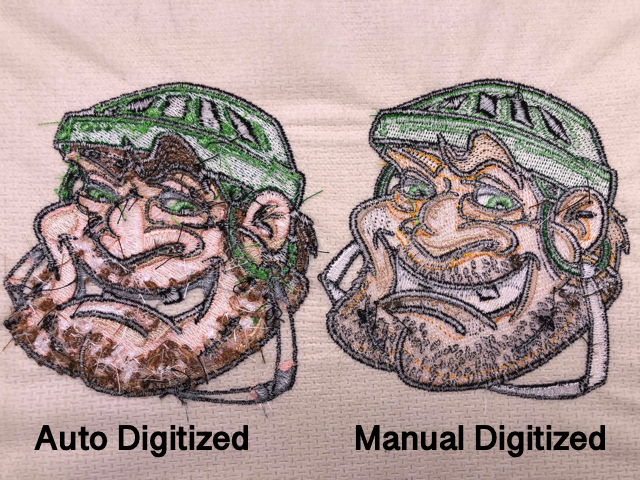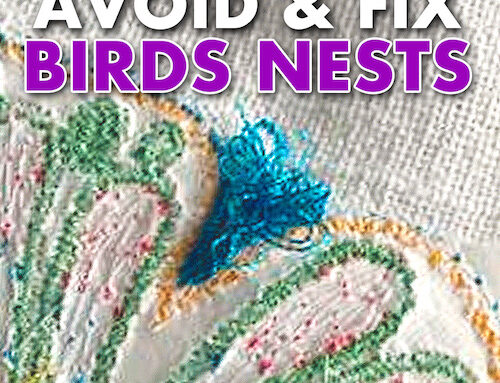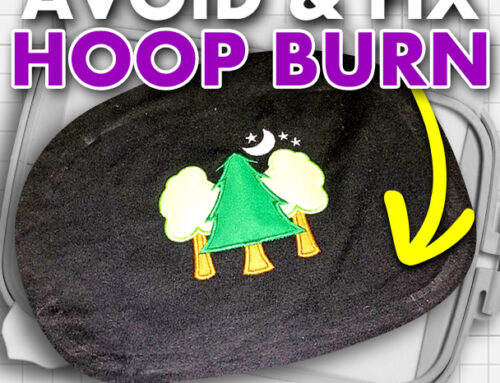Many embroiderers struggle with bulletproof embroidery when using auto-digitizing software. You click “auto-digitize” and expect the design to come out perfect or at least close to perfect, but that is seldom the case.
This is not because the software itself is flawed, but sometimes it needs the help of an expert – you. For those looking to expand their skills and knowledge of digitizing and take your embroidery to the next level, this article is for you.

We’ll explain auto digitizing vs. manual digitizing, when it is appropriate to use them, and what you can do to improve your use of both. First, let’s cover the basics.
What Is Auto Digitizing with Embroidery Software?

Embroidery auto digitizing software uses computing to capture graphics/design images and translate them into machine embroidery design files. The software will decide on the appropriate layers, stitch counts, colors, and more, based on the algorithms it uses to digitize a logo or graphic.
Auto digitizing is used to save time and effort, but in doing so, it can cause structural and stitching problems with your designs. This is especially true when auto digitizing more complex designs. We’ll get to this a little further down.
What Is Manual Digitizing with Embroidery Software?

Manual digitizing is when the embroiderer uses embroidery software to manually translate an image or design into embroidery. The embroiderer gets to choose how the design will stitch out, in what order the layers will come together, stitch angles, and which colors to use.
Embroidery auto digitizing software can be great if used correctly and perhaps on simpler graphics, supplemented by manual digitizing skills. Manual digitizing skills always go a long way to help you get the quality results you want.
Does Embroidery Auto Digitizing Software Work?
Yes and no. It depends on the complexity of the logo and graphic used and the operator’s skill. In the hands of a novice who doesn’t know better, embroidery auto digitizing software will seem to work wonders, but in the eyes of an experienced digitizer, the problems with some auto digitizing work couldn’t be more obvious.
Auto digitizing software does exactly what it’s meant to do, but sometimes it doesn’t do things in a logical order or in a way that will translate well to embroidery. The software takes what it sees in the order it was presented, and digitizes it. It’s not capable of distinguishing better angles or fills for a cleaner design. That’s your job.


Notice all the jump stitches and trims in the auto digitzed designs above. That leads to thick “bullet-proof” embroidery, threadbreaks, and more time/frustration running the design on your machine.
Check out our YouTube video below as CEO of Embroidery Legacy John Deer goes further into detail comparing auto digitizing to manual digitizing. Watch as John corrects an auto digitized design:
What if I use High-Quality Images?
Good images will usually yield better results when hitting “auto-digitize,” but that’s not always the case. Even if you use a vector file – a file that contains proper nodes, formatting, and resolution – it’s not always optimized for machine embroidery.
When an artist creates a design in CorelDraw or Adobe Photoshop, they don’t consider that the design needs to be embroidered in a specific order or sequence that only a machine embroiderer would understand.
The embroidery software will auto-digitize the design based on the layers the artist created in their graphic, which might cause excessive stitch counts, incorrect push and pull compensation, too many jumps and trims, and image distortion.
Manual digitizing is a great skill to have when working with images you’d import to be embroidered. It allows you to adjust, improve, and correct imported illustrations. You’ll ultimately create a better piece, with less time spent fixing mistakes.
Watch our YouTube video below to learn more about using vector graphics to automatically digitize a design.
Should I Learn How To Digitize?
The answer is yes. You don’t need to become the best digitizer in the world. You just need enough skills to make your job easier and your work better. You’ll find plenty of ways to use manual digitizing skills to save you time and hassle.
If hitting “auto-digitize” isn’t getting you the result you want, and most of the time it won’t without tweaking, there’s a good chance that digitizing it yourself or at least knowing how to fix the auto-digitized design with manual digitizing knowledge will help you achieve the results you want.
However, correcting auto-digitized work can take hours. Complex designs that are auto-digitized will require lots of editing to get a good result with your machine. You’ll have to adjust the image node by node, stitch by stitch, to not make it bulletproof. The alternative is to digitize it yourself, using your image as a template. Believe it or not, in most cases, this is a much faster way to generate quality results.
Watch our YouTube video below as John compares semi-automated and auto-digitizing tools to compare the results. Regardless what tool you choose, to ensure quality results it will require editing the design to achieve reasonable results.
Which Graphics Software Should I Learn?
None! You should learn to use embroidery digitizing software. When importing images or graphics into your digitizing software, you’ll be adjusting nodes and creating your own graphics within the software anyway for machine embroidery.
There’s no need to learn graphics software to then import the image into a digitizing software and adjust it or re-digitize it all over again. It’ll save you stress from learning good digitizing software and creating your designs at the source, where any other graphic or file would ultimately end up.
Try It Yourself
If you want to see exactly how auto-digitizing works and understand where you can make improvements by manually digitizing, download a trial version of any reputable digitizing software. Doing this is an excellent first step to understanding more about digitizing for free.
What Digitizing Software Is The Best?
Any reputable digitizing software will do, but we’d recommend a brand that provides excellent support. When deciding on a software brand, it’s best to find one with the most relevant and effective training resources. Sometimes cheaper brands will seem desirable for their relatively low cost, but it becomes a burden when you discover that the manual and training resources are hard to understand or poorly written. Not to mention, their algorithms may not be as advanced or their layout as user friendly.
We’d recommend what we use, Hatch embroidery software. Hatch is a popular industry standard. The parent company Wilcom has been around for 30 years, infusing their software with tried and tested knowledge, tools, and resources. The learning curve is friendly, and like any software, it will take a bit of getting used to. Also if you order Hatch through Embroidery Legacy we’ll include up to $235 added Hatch embroidery software bonuses, who doesn’t want free stuff!
Hatch 30 Day Free Trial

We want to provide our audience with useful information and products to use in their machine embroidery. That’s why we teamed up with Hatch to offer you a 30-day free trial. It’s entirely free for you to try and get your feet wet with digitizing or even auto-digitizing. Just click here to download your free trial now.
Hatch has many features, but one that we like best is the Fabric Assist tool. It allows you to automatically recalibrate your design for any fabric type with the click of a button. This little feature can save you an enormous amount of time and stress. Instead of manually having to adjust a design’s properties for different fabric types, the software does it at the click of a button for you! There are many other great things Hatch has to offer, but see them for yourself.
With the Hatch 30-day free trial, we want to help get you started and digitizing. That’s why we’ll include our free Embroidery Digitizing Made Easy Challenge. This challenge has been designed to help you dive into digitizing, even if you’ve never tried it before.
Don’t stress about where to begin or what to focus on first. We’ll guide you through the entire process of creating 6 designs yourself using Hatch. The challenge has an easy to follow format consisting of 7 instructional videos designed for the beginner in mind. Throughout it, you’ll learn a ton of manual digitizing theory that can be used to help you adjust auto-digitized designs or create them yourself from scratch. Plus, in general, learning some basic digitizing theory will help improve every aspect of your machine embroidery by truly understanding what’s happening under your needle.
Take Your Digitizing To The Next Level
We want you to become a great embroiderer, and to do that, you need to focus on developing the right skills. Having manual digitizing knowledge is a must. We wanted to address embroidery auto-digitizing software to bring to attention that it’s a far cry from a be-all-end-all solution. If you’re going to become a skilled professional, learning to digitize is the way to go.
That’s why we offer a free trial with Hatch and a free digitizing challenge. We want to make it easy for you to get started, to feel like you know where to begin and what you are doing when you open up your digitizing software. To make sure that you can fast track through the learning curve, we’ve created something unique just for you.
The Digitizers Dream Course

We are offering a course to supplement our excellent free resources. Imagine being able to digitize your own designs in minutes and with confidence. You can take graphics or designs, and instead of settling for “auto-digitize,” you can do it yourself.
The Digitizers Dream Course is designed to hold your hand every step of the way. It’s laid out to bypass frustration and teach you things it would take you days, if not weeks, to learn on your own. There’s nothing else quite like it in the industry.
This course applies to any of the major reputable digitizing brands. You select the brand of the software you own, and the course is tailored to that software specifically.

When it comes to machine embroidery, there are 3 primary stitch types you need to know. The course is broken down into 3 parts focused on these stitch types. For example, the running stitch is the most common stitch type in machine embroidery and crucial to understand when you’re digitizing.
The first part of the course, or “Level 1,” will teach you everything you need to know about the running stitch, including some of the industry’s best kept secrets on digitizing and how to apply the knowledge in your own projects.
The first level of the course offers 4 hours of interactive video, which will guide you through the process of digitizing 12 designs on your own. From there, we offer Level 2 and Level 3, that goes in-depth about the fill stitch, satin stitch, and how to digitize using those stitches.
Conclusion
Although auto-digitizing may seem like a clean solution to getting your designs digitized quick, most of the time, it isn’t. Any software brand does the best it can to digitize the designs automatically, but they all require some human assistance, and in most cases, manual digitization.
That’s why we wanted to shed light on the situation. Even with high-quality vector files, auto-digitizing might not generate the best results. Having the skills to digitize designs and images manually is a must.
Remember, there is no need to learn to use a graphics software if you’ll be bringing images into a digitizing software anyways. You’d basically be creating the same design twice and wasting your valuable time.
It doesn’t matter what digitizing software you choose to use, as long as it’s reputable. Of course, we recommend Hatch software given its ease of use and advanced tools. We always suggest you try out embroidery software before buying to see what best fits your needs. But remember, the software is only as good as the education and support behind it, and the Embroidery Legacy is here to help you along your embroidery journey every step of the way. To see for yourself why we encourage embroiderers to use Hatch and for a free 30-day trial of the software, click here.
Plus, if you’ve never tried our education before, the beautiful thing about downloading the free Hatch trial through us is that you’ll also get access to our fan-favorite Digitizing Made Easy Challenge.
If you decide to add digitizing to your arsenal of machine embroidery skills, we think you’ve made the right choice. It will push you to become a better embroiderer. After you’ve tried our free challenge or if you own a software brand other than Hatch, our Digitizers Dream course will have you on your way in no time, with the knowledge and theory to create your own beautiful embroidery designs.






I bought my software at the same time as my 1st embroidery machine. A skilled seamstress with over 50 years of experience & retired IT, I cannot believe how stupid I was about this purchase. I can only explain it as being brain dead. My daughter had died just weeks before & I was hoping to fill my time by expanding sewing into an entirely new area. I researched the sewing machine, but not the software. Really inexplicable for an IT professional. I bought a BabyLock Solaris. I told the clerk I wanted to learn to digitize & she steered me away from Palette 11 to Premier+2 Ultra insisting it was a more robust set of tools. I was so numb, so immersed in grief, I didn’t even ask if there were other software programs available in the open market. The shop does offer free lessons for the software it sells, but I have no knowledge of its content or quality. Distance from the shop made the lessons inaccessible to me. I will guess you know the price of this software; more than double the price of Hatch. And I have since learned from a variety of sources that Hatch is the best software available for the home digitizer. You have no idea the depth of my regret. I want Hatch badly, but cannot afford to walk away from a $2000 investment. I am going to download this 30 day trial & the free course that accompanies it which will just leave me wanting it more. And then I look at your 3 level course for $100 & this super expensive so unfriendly program I own isn’t even in the list of supported software for it. What can I do? Are ANY of the supported software remotely like P2 ULTRA or am I just stuck with this expensive albatross bought at the worst time in my life with just horrible opportunistic advice given by a greedy clerk?
Hi Ellen, I’m sorry to hear you’re not happy with your software. Unfortunately we don’t offer any education in that software but the theory we teach with our free digitizing lesson & free 30-day Hatch trial can be applied to your software.
Hello, I have Wilcom software and am thoroughly enjoying your teaching. I purchased the dream course and watch your YouTube videos. I am learning so much and wish I had this knowledge a few years ago when I ran a small custom apparel business. Would have saved me a lot of money in digitizing fees.
Looking forward to the patches videos. Thank you again.
Cindy Garner
Thanks for your support Cindy, keep an eye out for the patches videos soon 🙂